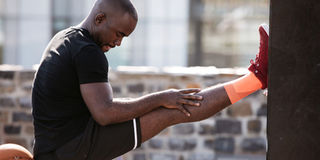Prime
Why you need functional range conditioning

FRC helps you build control and strength in new ranges of motion. Photo | Gettyimages
What you need to know:
- Think of functional range conditioning training as flossing for your joints. Regularly flossing your teeth prevents junk build up, and improves the overall health of your teeth as a result. The same goes for your joints.
Functional Range Conditioning (FRC) helps you to become more aware of your body and allows you to complete linear movements with ease. This exercise was developed by movement specialist Dr Andreo Spina as a mobility training system created to improve joint health.
Many people suffer from stiff or tight muscles, which hinders mobility. Both mobility and flexibility are important areas to develop if you are looking to enhance your workout routine, or improve joint health and function. FRC works on controlling different ranges of motion, which is essentially training your mobility.
Felix Kamya, a fitness trainer at the Fitness Hub in Kampala, says: “The aim is to fuse flexibility and mobility in order to improve one’s movement abilities safely. Additionally, the person should be able to control their body even in tight spots where joint movements are difficult. It takes practice and sustained work to turn previously unused motion ranges into easily usable movement patterns.”
For instance, for one to ably touch their toes without injuring their back, it is important that they work on how to improve their stability, backbone and hip strength as well as their active mobility.
“That will greatly improve one’s ability to maintain their position when moving under a heavy load, say during weightlifting. While you will not necessarily become stronger, though it cannot be totally ruled out, your tissues’ ability and capacity to bear load is enhanced. This is the use of FRC,” Kamya says.
Strength
Cyrus Mubangizi, a fitness trainer at Body Image Fitness Centre, says FRC is essentially end-of-range strength and control training. He explains that end-of-range strength is about exerting force when a muscle is short or long such as raising your leg to that point when you can lift it no more. At that point, you have got to the end-of-range point as well as the end of your active mobility.
There are some exercises you can do to make this conditioning a reality and this is achieved through Controlled Articular Rotations (CARS).
CARS, Mubangizi says, helps with muscle irradiation (the ability of a muscle performing an action to generate greater tension by being stimulated from the surrounding muscles), where the body can perform actions to generate tension or force through being stimulated by the surrounding muscles.
“This technique is essential for any weight lifter and it is necessary because it helps you to be present in every movement you make,” he says. Some of the CARS include:
Neck CARS
Mubangizi says when engaging in this workout, the body should not move with the motions but remain stable and only focus on moving the neck and head. “Neck CARS can be done alone or incorporated into a routine,” he says.
Procedure
According to youaligned.com, stretch your neck as much as possible as you bring the chin to the collarbone. Then swing the chin up to the left as you look to the ceiling before bringing the left ear back to the left back pocket.
Thereafter, using your chin, draw an imaginary line on the ceiling while ensuring the teeth are firmly clenched and your entire body is stable.
Switch positions to bring your right ear to the right back pocket before lowering your chin to your shoulder and scraping it on your collarbone. Thereafter, move your head back to the centre of your body to reset.
After that, go through the same motions but in the reverse direction. However, Mubangizi reminds beginners that learning the art of irradiation is not inborn but learnt.
“Therefore, work with a trainer who is knowledgeable about FRCs,” he says, adding that one should repeat these motions twice or thrice.
Knee CARS
These motions are meant to work on the shin bone (tibia) since it is vital for knee and the entire joint health. While engaging in knee CARS, Mubangizi says, one’s hips should not follow through with the rotation movements but rather, ensure they are as stable as possible.
“Irradiation comes into play here as well. However, it is important to note that you will not know how to do this as a beginner, hence the need to enlist the help of a professional fitness trainer,” he says.
Procedure
In a seated position and legs stretched out in front you, yet with bent knees, wrap your right arm underneath the right leg and place your left hand on top of your knee.
At this point, irradiate at 30 percent before rotating your right foot inwards yet pushing as far as possible without losing your balance.
Then, extend your knee yet sustaining the internal rotation and at your end-of-range strength point (unable to rotate any further), switch to external rotation.
Thereafter, lower the leg slowly and push it out back to the top without getting the foot out of the external rotation. Then, rotate the foot internally followed by lowering the leg to the floor.
Do the same with the left leg and repeat that two to three times.
While these workouts can easily be done at home, Kamya emphasises the need for beginners to work with a trainer.
Who can benefit?
Overall, everyone can benefit from FRC since everyone moves. Injury is not limited to just athletes, and functional movements are not just limited to athletes either.
Not only does FRC help to improve the mobility of the human body and develop improved load capacity in the joints, but it also improves body control. Body control is one of the critical factors in reducing the occurrence of injury and painful conditions that frequent training and sport.





